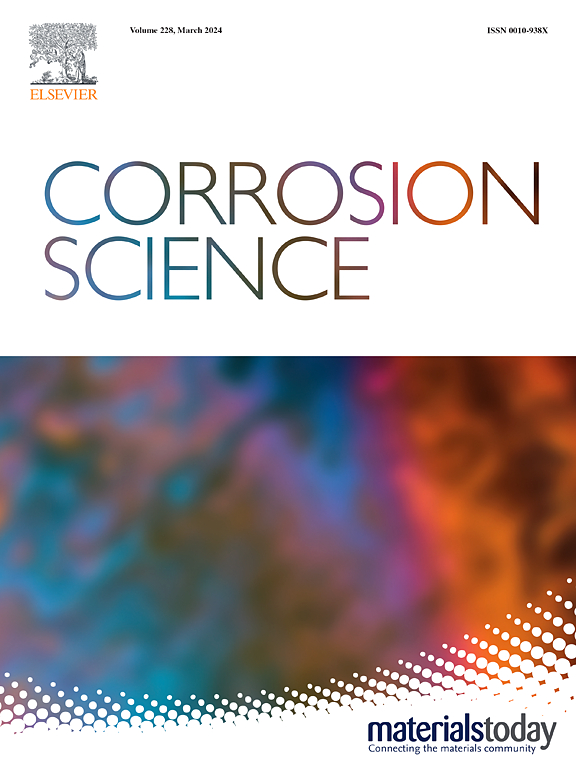掺入微量梯度 W 的氢化无定形碳涂层的超强耐摩擦腐蚀性能
IF 7.4
1区 材料科学
Q1 MATERIALS SCIENCE, MULTIDISCIPLINARY
引用次数: 0
摘要
在这项工作中,我们在热喷涂碳化钨基金属陶瓷的氢化无定形碳(a-C:H)涂层中加入了微量梯度 W,并增加了表层厚度。在 3.5 wt% 的 NaCl 溶液中,通过摩擦过程中的结构演变研究了改性 a-C:H 涂层的耐摩擦腐蚀性。尽管 a-C:H 涂层保持了 sp2/sp3 原子键结构,但无论引入何种梯度 W 掺杂,涂层都获得了应力减小和塑性增加的效果。此外,稳定的开路电位表明,改性涂层的耐摩擦腐蚀性能显著提高,磨损率和摩擦系数分别为 1.46×10-8 mm3/N-m和 0.067 COF,磨损率和摩擦系数相当低。与传统的 a-C:H 涂层在氯化物溶液中的磨损和点蚀失效不同,设计的坚固界面和功能性表层使涂层在 1.67 GPa 的重接触压力下能够承受超过 2100 米的最长滑动距离。这些观察结果为制造具有极强耐磨性和防腐能力的先进碳基涂层提供了可行的策略,可用于恶劣海洋环境中使用的机械部件。本文章由计算机程序翻译,如有差异,请以英文原文为准。
Ultrahigh tribocorrosion resistance of hydrogenated amorphous carbon coating via trace gradient W incorporation
In this work, we manipulated the trace gradient W incorporation combined with a increment top-layer thickness for the hydrogenated amorphous carbon (a-C:H) coating on thermally sprayed WC-based cermet. The tribocorrosion resistance of the modified a-C:H coating was investigated in terms of structural evolution during friction under 3.5 wt% NaCl solution. Regardless of introduction of gradient W doping, although the a-C:H coating maintained the sp2/sp3 atomic bond structure, the stress reduction and plasticity increase were obtained for coatings. Moreover, the stable open-circuit potential revealed that the tribocorrosion resistance of modified coating was significantly improved, as identified by the quite low wear rate and coefficient of friction at 1.46×10−8 mm3/N·m and COF of 0.067, respectively. Different with the traditional failure of worn-out and pitting corrosion of a-C:H coating in chloride solution, the designed robust interfaces and the functional top-layer enabled the coating to withstand longest sliding distance over 2100 m at heavy contacting pressure of 1.67 GPa. These observations offer the promising strategy to fabricate advanced carbon-based coatings with required extremely strong wear resistance and anticorrosion capability for mechanical components used in harsh marine environment.
求助全文
通过发布文献求助,成功后即可免费获取论文全文。
去求助
来源期刊

Corrosion Science
工程技术-材料科学:综合
CiteScore
13.60
自引率
18.10%
发文量
763
审稿时长
46 days
期刊介绍:
Corrosion occurrence and its practical control encompass a vast array of scientific knowledge. Corrosion Science endeavors to serve as the conduit for the exchange of ideas, developments, and research across all facets of this field, encompassing both metallic and non-metallic corrosion. The scope of this international journal is broad and inclusive. Published papers span from highly theoretical inquiries to essentially practical applications, covering diverse areas such as high-temperature oxidation, passivity, anodic oxidation, biochemical corrosion, stress corrosion cracking, and corrosion control mechanisms and methodologies.
This journal publishes original papers and critical reviews across the spectrum of pure and applied corrosion, material degradation, and surface science and engineering. It serves as a crucial link connecting metallurgists, materials scientists, and researchers investigating corrosion and degradation phenomena. Join us in advancing knowledge and understanding in the vital field of corrosion science.
 求助内容:
求助内容: 应助结果提醒方式:
应助结果提醒方式:


